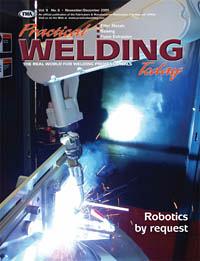Contributing Writer
- FMA
- The Fabricator
- FABTECH
- Canadian Metalworking
Categories
- Additive Manufacturing
- Aluminum Welding
- Arc Welding
- Assembly and Joining
- Automation and Robotics
- Bending and Forming
- Consumables
- Cutting and Weld Prep
- Electric Vehicles
- En Español
- Finishing
- Hydroforming
- Laser Cutting
- Laser Welding
- Machining
- Manufacturing Software
- Materials Handling
- Metals/Materials
- Oxyfuel Cutting
- Plasma Cutting
- Power Tools
- Punching and Other Holemaking
- Roll Forming
- Safety
- Sawing
- Shearing
- Shop Management
- Testing and Measuring
- Tube and Pipe Fabrication
- Tube and Pipe Production
- Waterjet Cutting
Industry Directory
Webcasts
Podcasts
FAB 40
Advertise
Subscribe
Account Login
Search
Electrode storage myths and rod oven temperatures
- By Marty Rice
- Updated February 7, 2024
- November 10, 2014
- Article
- Arc Welding
Welders often ask me, “Can I dry welding rods in my oven if they have gotten wet?” and “Can I put 7018 welding rods in my freezer for a certain amount of time if they are old?”
The 7018 electrode is a low-hydrogen rod, which means it doesn’t tolerate moisture in its flux. If you’ve welded with 7018 that has moisture in it, you’ve discovered the meaning of porosity, or wormholes, a major welding defect.
Storage Myths
If someone’s told you that you can dry wet welding rods in your oven or put rods in a freezer if they are old, you’ve heard two welding myths.
Another myth is that you can put a light bulb in an old refrigerator and store your welding electrodes in it. First, you can’t open the door from inside many old refrigerators, so any curious kid prowling around the job site can climb in and suffocate. On top of that, a light bulb won’t emit enough heat to keep welding electrodes at the proper temperature.
Oven Temperatures
Using a home oven to recondition welding rods is another unwise choice. The fire department likely will visit your house, because most rods require 500 to 700 degrees for reconditioning for anywhere from 30 minutes to four hours.
The old saying “Use the right tool for the job” comes to mind here. If you’re welding at home, you can buy an inexpensive rod oven that uses regular 110-V electricity. Bigger, more efficient, and affordable ovens are available for bigger jobs or shops.
About the Author

Marty Rice
High School Career Center in Texas
Questions for the author can be e-mailed to vickib@thefabricator.com
About the Publication
subscribe now

The Welder, formerly known as Practical Welding Today, is a showcase of the real people who make the products we use and work with every day. This magazine has served the welding community in North America well for more than 20 years.
start your free subscription- Stay connected from anywhere

Easily access valuable industry resources now with full access to the digital edition of The Fabricator.

Easily access valuable industry resources now with full access to the digital edition of The Welder.

Easily access valuable industry resources now with full access to the digital edition of The Tube and Pipe Journal.
- Podcasting
- Podcast:
- The Fabricator Podcast
- Published:
- 04/16/2024
- Running Time:
- 63:29
In this episode of The Fabricator Podcast, Caleb Chamberlain, co-founder and CEO of OSH Cut, discusses his company’s...
- Industry Events
16th Annual Safety Conference
- April 30 - May 1, 2024
- Elgin,
Pipe and Tube Conference
- May 21 - 22, 2024
- Omaha, NE
World-Class Roll Forming Workshop
- June 5 - 6, 2024
- Louisville, KY
Advanced Laser Application Workshop
- June 25 - 27, 2024
- Novi, MI
































